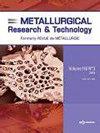Comparative analysis of the effect of Ca and Mg-Al modification on the composite inclusions in S50C Die steel
IF 0.9
4区 材料科学
Q3 METALLURGY & METALLURGICAL ENGINEERING
引用次数: 1
Abstract
At present, the effective ways to improve the cleanliness of S50C die steel are Ca or Mg-Al treatment processes. In order to explore the effect difference of two kinds of modification process of S50C killed steel, evaluate the industrial application prospect of the two processes, and clarify the modification mechanism. In this paper, the advantages of Mg-Al modification are demonstrated from the aspects of theoretical basis and actual sample modification effect. The thermodynamics and kinetics of inclusion precipitation, composition, morphology, and distribution are analyzed. The results show that: the precipitation temperature of MnS in S50C die steel is 1686 K, the corresponding solid-phase rate is 0.98. In Mg-Al modification, when the Al content is 332 ppm, the Mg content should be controlled below 14.1 ppm. When the Al content is higher than 0.02%, the Ca content should be controlled below 28.7 ppm. Kinetic calculations show that the equilibrium shape size of MnS is in the range of 0.3‑1.4 µm. Both modifications increase the nucleation rate of inclusions and control the shape and size of inclusions by pre-precipitation. Ca treatment is preventing the formation of large inclusions by forming calcium aluminate. Mg can provide more uniform nucleation sites and form smaller inclusions.Ca和Mg-Al改性对S50C模具钢复合夹杂物影响的对比分析
目前,提高S50C模具钢洁净度的有效途径是Ca或Mg-Al处理工艺。为了探讨S50C钢两种改性工艺的效果差异,评价两种工艺的工业应用前景,阐明改性机理。本文从理论基础和实际样品改性效果两方面论证了Mg-Al改性的优越性。分析了夹杂物析出、组成、形貌和分布的热力学和动力学。结果表明:MnS在S50C模具钢中的析出温度为1686 K,固相速率为0.98;在Mg-Al改性中,当Al含量为332 ppm时,Mg含量应控制在14.1 ppm以下。当Al含量高于0.02%时,Ca含量应控制在28.7 ppm以下。动力学计算表明,MnS的平衡形状尺寸在0.3 ~ 1.4µm之间。这两种变质均通过预沉淀作用提高了夹杂物的成核速率,控制了夹杂物的形状和大小。钙处理通过形成铝酸钙来防止大包裹体的形成。Mg能提供更均匀的核位,形成更小的包裹体。
本文章由计算机程序翻译,如有差异,请以英文原文为准。
求助全文
约1分钟内获得全文
求助全文
来源期刊

Metallurgical Research & Technology
METALLURGY & METALLURGICAL ENGINEERING-
CiteScore
1.70
自引率
9.10%
发文量
65
审稿时长
4.4 months
期刊介绍:
Metallurgical Research and Technology (MRT) is a peer-reviewed bi-monthly journal publishing original high-quality research papers in areas ranging from process metallurgy to metal product properties and applications of ferrous and non-ferrous metals and alloys, including light-metals. It covers also the materials involved in the metal processing as ores, refractories and slags.
The journal is listed in the citation index Web of Science and has an Impact Factor.
It is highly concerned by the technological innovation as a support of the metallurgical industry at a time when it has to tackle severe challenges like energy, raw materials, sustainability, environment... Strengthening and enhancing the dialogue between science and industry is at the heart of the scope of MRT. This is why it welcomes manuscripts focusing on industrial practice, as well as basic metallurgical knowledge or review articles.
 求助内容:
求助内容: 应助结果提醒方式:
应助结果提醒方式:


